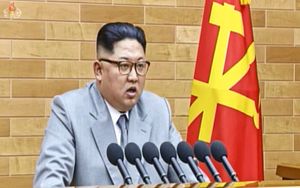North Korean leader Kim Jong-un has rung in the new year with a bang. After all, why wouldn’t he? Despite three rounds of sanctions resolutions against his country at the UN Security Council, Kim’s 2017 was a success.
Not only did he oversee the successful launches of two new intercontinental ballistic missiles, bringing the U.S. homeland within range of his nuclear weapons, but North Korea also carried out its first test of a claimed thermonuclear weapon. Whatever the device was that North Korea tested under Mount Mantap in September 2017, it was the most powerful explosion on Earth since China set off the largest underground nuclear test it had ever conducted, in 1992.
Accordingly, on New Year’s Day, Kim Jong-un declared his country’s nuclear forces “completed” and said he now possessed a deterrent sufficient to render a U.S. attack on North Korea unthinkable. Kim, with his typical panache, said that a physical button to launch a nuclear strike had been installed in his office.
Setting aside the question of a physical button – Kim no doubt will have other arrangements for authorizing a nuclear strike – the North Korean leader’s triumphant declarations must be taken seriously. U.S. strategists and officials are still coming to terms with their new-found vulnerability to North Korean nuclear weapons in the U.S. mainland.
While calls for preventive war continue to loom large in the United States, the risks remain unbearably high. Any war with North Korea today will necessarily become a nuclear war; even if the U.S. were to strike first, North Korea likely would be able to strike targets in South Korea and Japan with nuclear weapons, causing suffering of a magnitude far greater than its long-standing artillery capabilities against Seoul might have wrought.
Kim’s New Year’s address, however, was about more than just his nuclear forces. While diplomacy was not particularly in vogue on the Korean peninsula in 2017 amid ballistic missile testing from the North that recurred regularly throughout the year, Kim decided to extend an olive branch to his idealistic, democratically elected counterpart in the South.
As the new year begins, regional observers are anxious about the Winter Olympic Games, which will be held in the South Korean resort town of Pyeongchang, some 50 miles from the demilitarized zone that separates the two Koreas. The games are set to begin in a little more than a month.
With little time left, Kim not only “earnestly” wished South Korea a successful experience as host nation, but also indicated that North Korea was “willing to dispatch” a delegation to the Games. “Since we are compatriots of the same blood as South Koreans, it is natural for us to share their pleasure over the auspicious event and help them,” Kim noted.
While all this may appear to be an unexpected moment of rapprochement and goodwill, it will not come without costs and conditions. If inter-Korean talks do take place at any meaningful level in the coming days, the primary North Korean demand is likely to concern the regularly scheduled US-South Korea Foal Eagle and Key Resolve joint military exercises.
“They should discontinue all the nuclear war drills they stage with outside forces, as these drills will engulf this land in flames and lead to bloodshed on our sacred territory,” Kim said, referring to these exercises.
South Korea has requested that the U.S. agree to delay the start of these exercises until the Paralympic Games conclude in March, but North Korea has long seen these kinds of mass mobilisation exercises as a ruse for preventive war. At a time when North Korea’s newly acquired ICBM capabilities pose an unprecedented challenge to the U.S.-South Korea alliance, Seoul cannot acquiesce to Pyongyang’s demands.
Even if a breakthrough is impossible in time for the Pyeongchang Games, Kim’s New Year’s Day address does cautiously lay out an optimistic path ahead for inter-Korean relations. President Moon’s hands will be tied by regional concerns and the demands of the Trump administration; but Kim’s statement that the two Koreas should “work together to ease the acute military tension” between them ought to be explored seriously in Seoul.
In 2017, as North Korea introduced an unusually diverse and advanced nuclear arsenal, the need for restored military-to-military contacts across the demilitarized zone became dangerously apparent. In 2018, the odds for deadly miscalculation will remain, even if North Korea’s ballistic missile and nuclear testing calendar may slow.
As the new year begins, the situation on the Korean Peninsula remains as precarious as ever. North Korea spent the last year showcasing an increasingly credible and sophisticated nuclear capability. In 2018, even as sanctions continue to weigh on Pyongyang, North Korea’s resolve to continue down this path likely will remain unswerving.
The inter-Korean olive branch is likely the most important takeaway from Kim’s speech. It gets at North Korea’s long-standing objective in Northeast Asia: to drive a wedge between the U.S. and its allies, with the eventual goal of breaking these alliances. Only time will tell if Kim can succeed, but U.S. policymakers should take care to ensure that a misguided attempt at reconciliation doesn’t leave the long-standing U.S.-South Korea alliance in disarray.
This article first appeared in the South China Morning Post. It is republished here with kind permission.

































